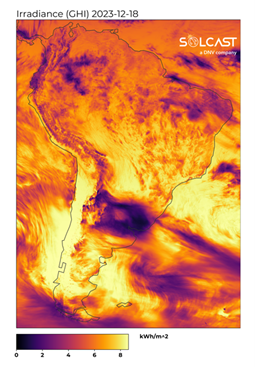El Niño has shown some signs of expected patterns across South America, as anomalous winds kept Brazil dry and sunny, whilst Argentina soaked through storms in December according to data analyzed by Solcast, via the Solcast API. Brazilian solar power production will have outperformed December expectations, with most of the country's utility scale assets receiving irradiance well above average irradiance. Argentina saw storms through the month, though the south of the country stayed mostly dry and saw some of the highest daily irradiance across the continent.

Brazilian solar producers benefited from a sunnier December than normal, with most areas receiving 20-30% above average irradiance for the month. Anomalous easterly winds kept Amazonian moisture well inland, with reduced cloud leading to less rainfall and increased irradiance. The bulk of Brazilian utility scale assets are concentrated in the East, so will have seen higher than expected production through the month. Rio De Janeiro also saw a sunny month, receiving more December irradiance than they have seen since 2014.

Without the tropical effects further North, Argentina saw a relatively moist airmass, leading to ideal conditions for large convective storms. Several large storms through the middle of the month, and on Christmas day brought flash flooding, and reduced December irradiance well below average. The localized effects can be seen in the daily irradiance figures, including on December 18, pictured above. Conversely, the South of the country received much drier and sunnier conditions, whilst around average for December, with significantly higher average daily irradiance than the North.
Popular content

Some of the normal expectations from El Niño weather effects have been muted, matching patterns seen around the world. Coastal Ecuador and Peru normally see increased rainfall and cloudiness in El Niño years, but this December saw neutral to slightly above normal irradiance. The Atacama Desert receives the highest levels of irradiance in the world, as the region is on the west coast under the sub-tropical ridge and is sheltered by the Andes mountain range. It saw the highest daily irradiance in the continent in December. The next highest was across Coastal and Southern Argentina, where westerly winds and sunny days were persistent in the lee of the Andes across December.
Solcast produces these figures by tracking clouds and aerosols at 1-2km resolution globally, using satellite data and proprietary AI/ML algorithms. This data is used to drive irradiance models, enabling Solcast to calculate irradiance at high resolution, with typical bias of less than 2%, and also cloud-tracking forecasts. This information is used by more than 300 companies managing over 150 GW of solar assets throughout the world.
The views and opinions expressed in this article are the author’s own, and do not necessarily reflect those held by pv magazine.
This content is protected by copyright and may not be reused. If you want to cooperate with us and would like to reuse some of our content, please contact: editors@pv-magazine.com.


3 comments
By submitting this form you agree to pv magazine using your data for the purposes of publishing your comment.
Your personal data will only be disclosed or otherwise transmitted to third parties for the purposes of spam filtering or if this is necessary for technical maintenance of the website. Any other transfer to third parties will not take place unless this is justified on the basis of applicable data protection regulations or if pv magazine is legally obliged to do so.
You may revoke this consent at any time with effect for the future, in which case your personal data will be deleted immediately. Otherwise, your data will be deleted if pv magazine has processed your request or the purpose of data storage is fulfilled.
Further information on data privacy can be found in our Data Protection Policy.